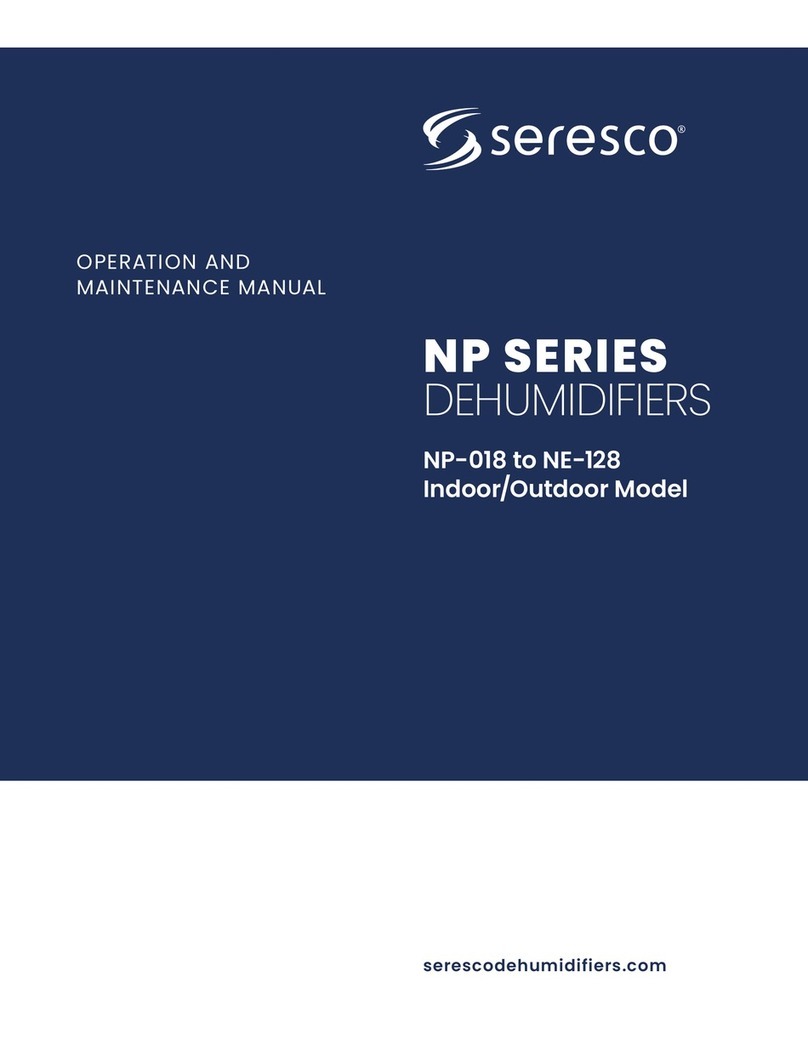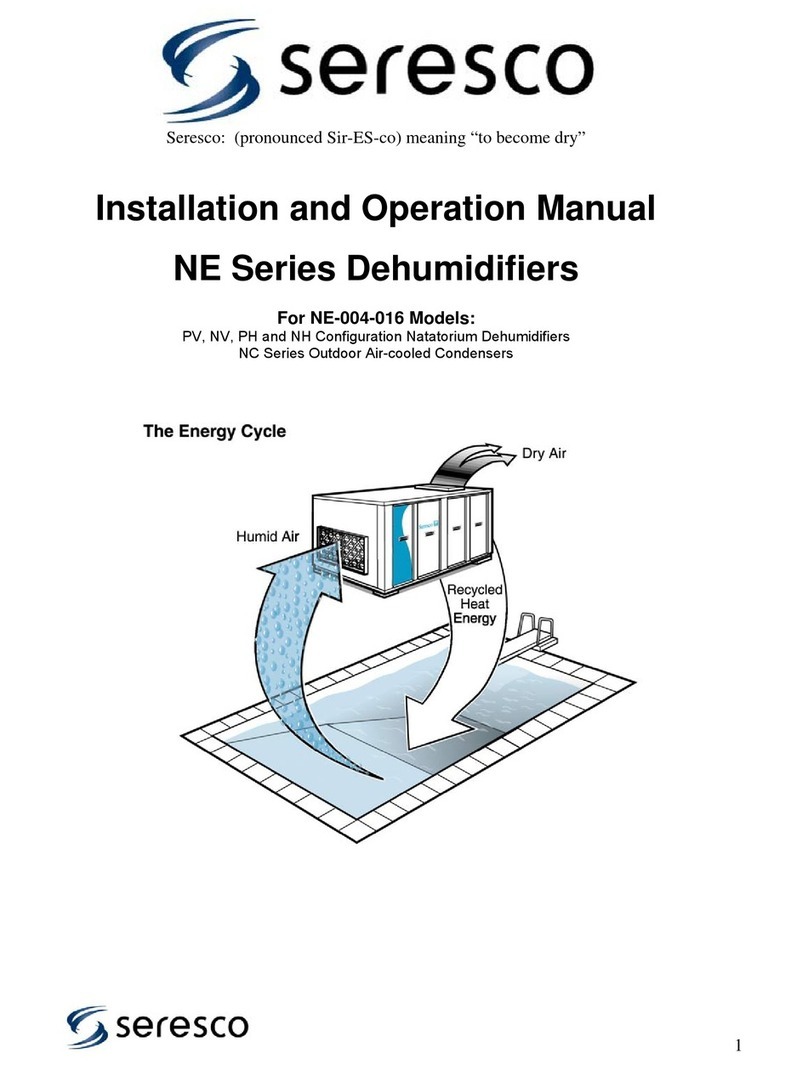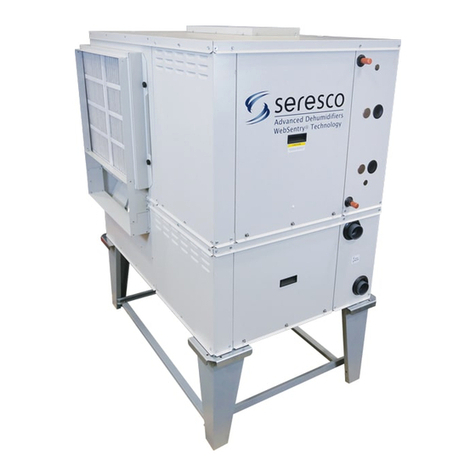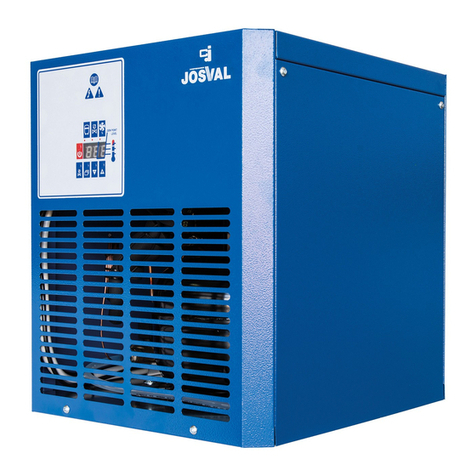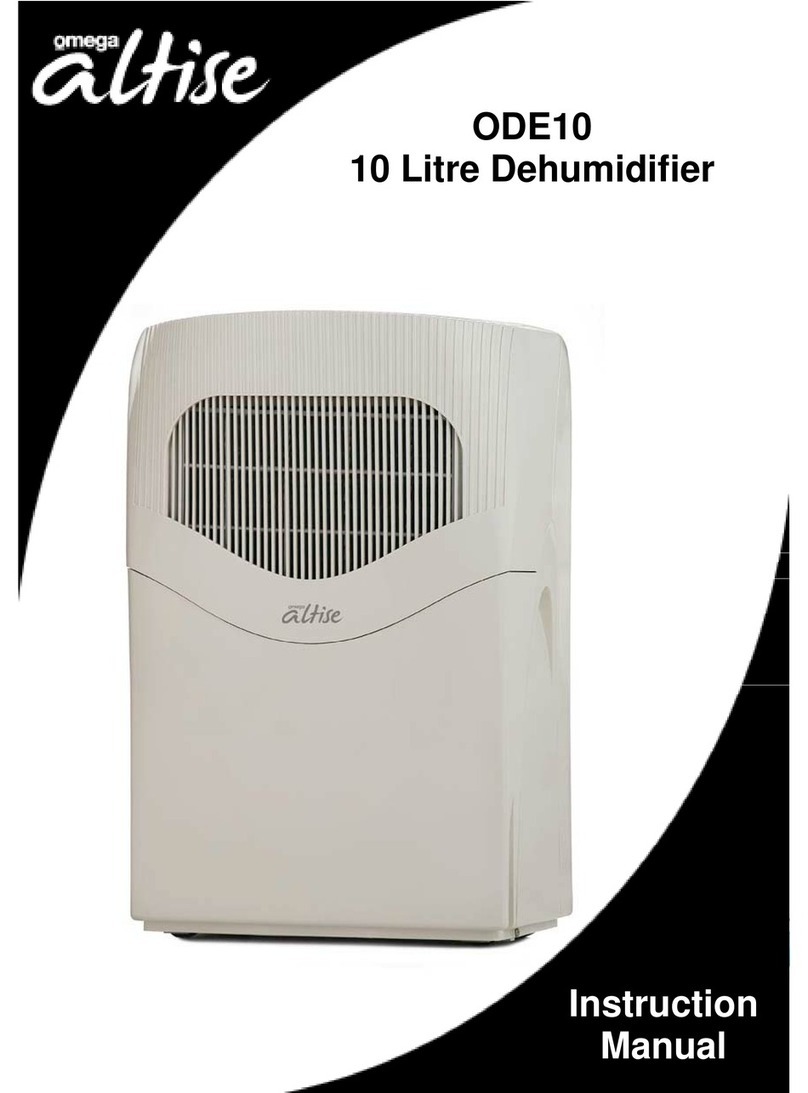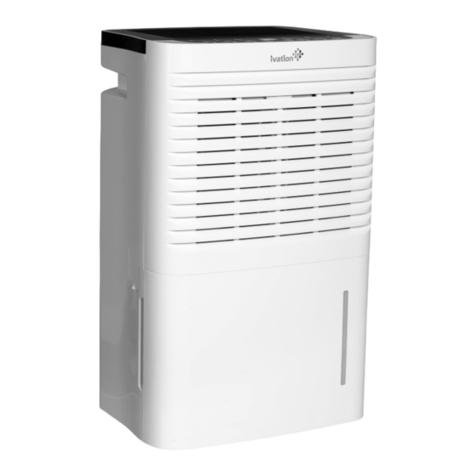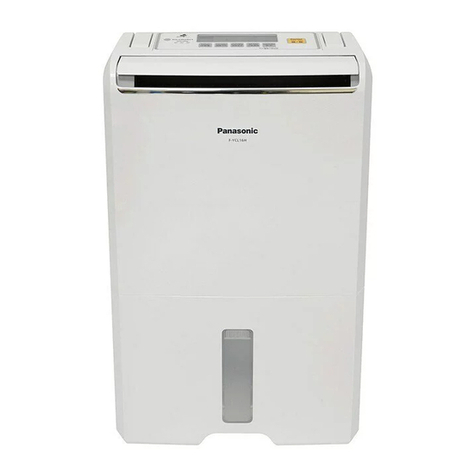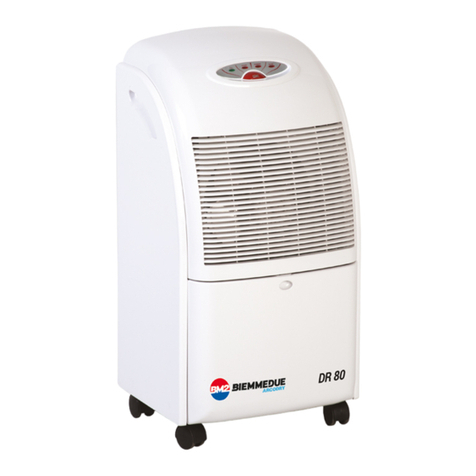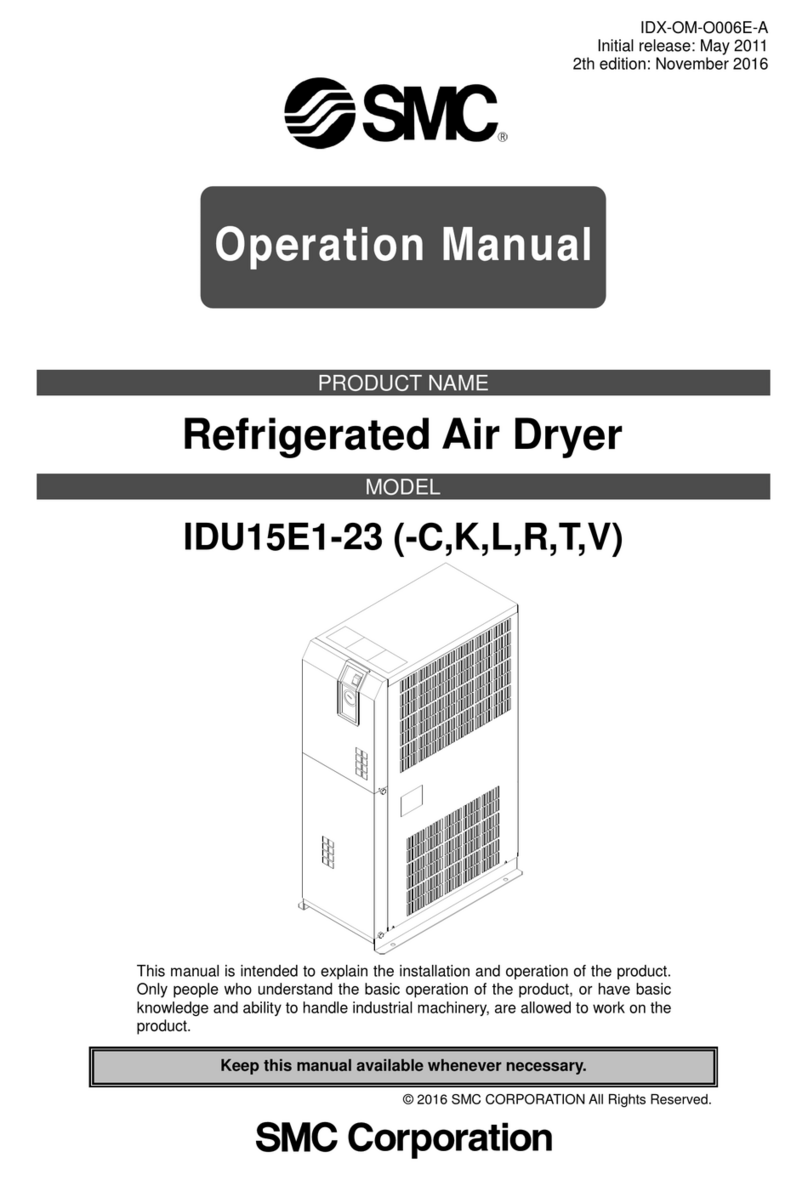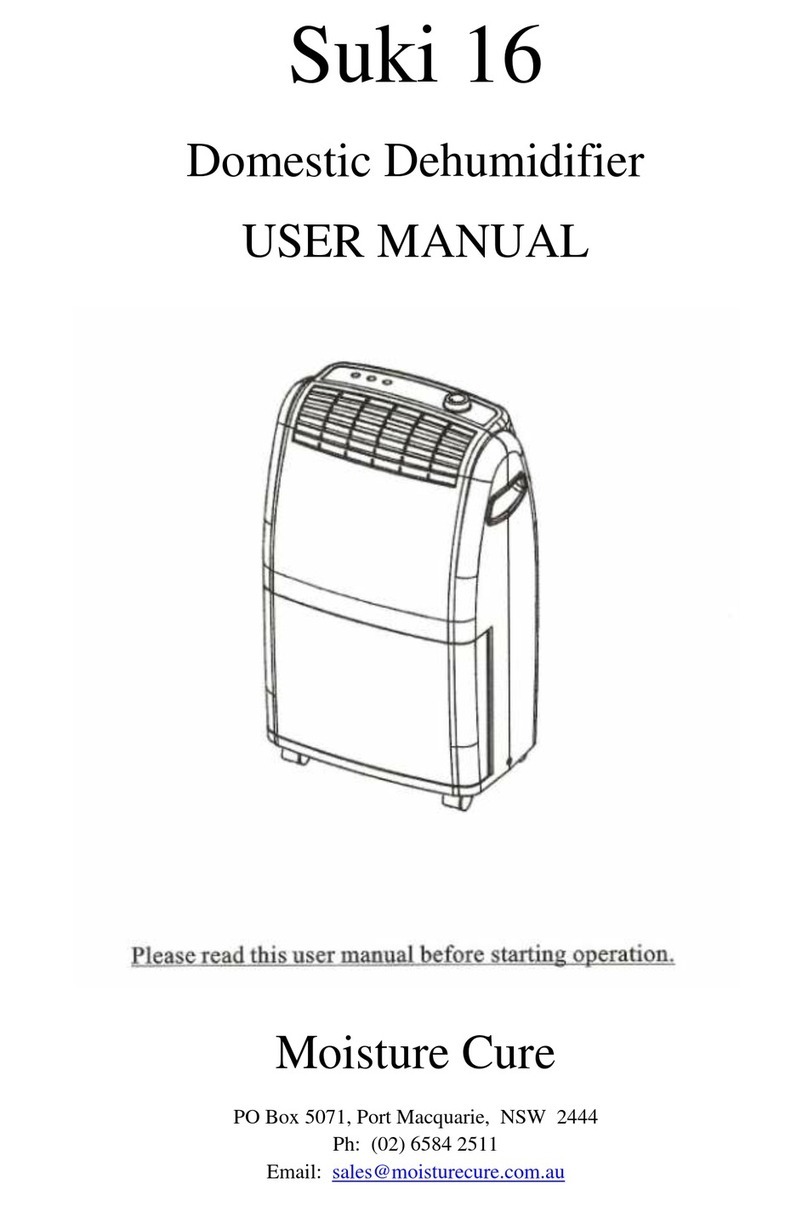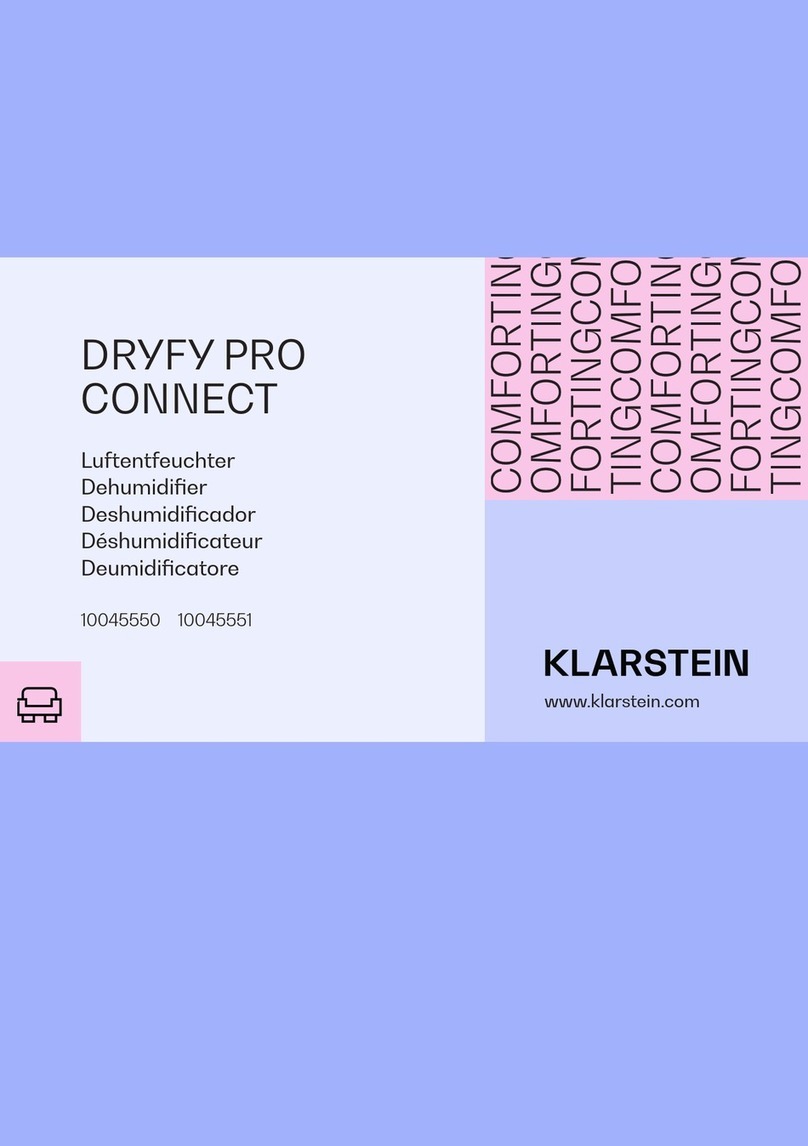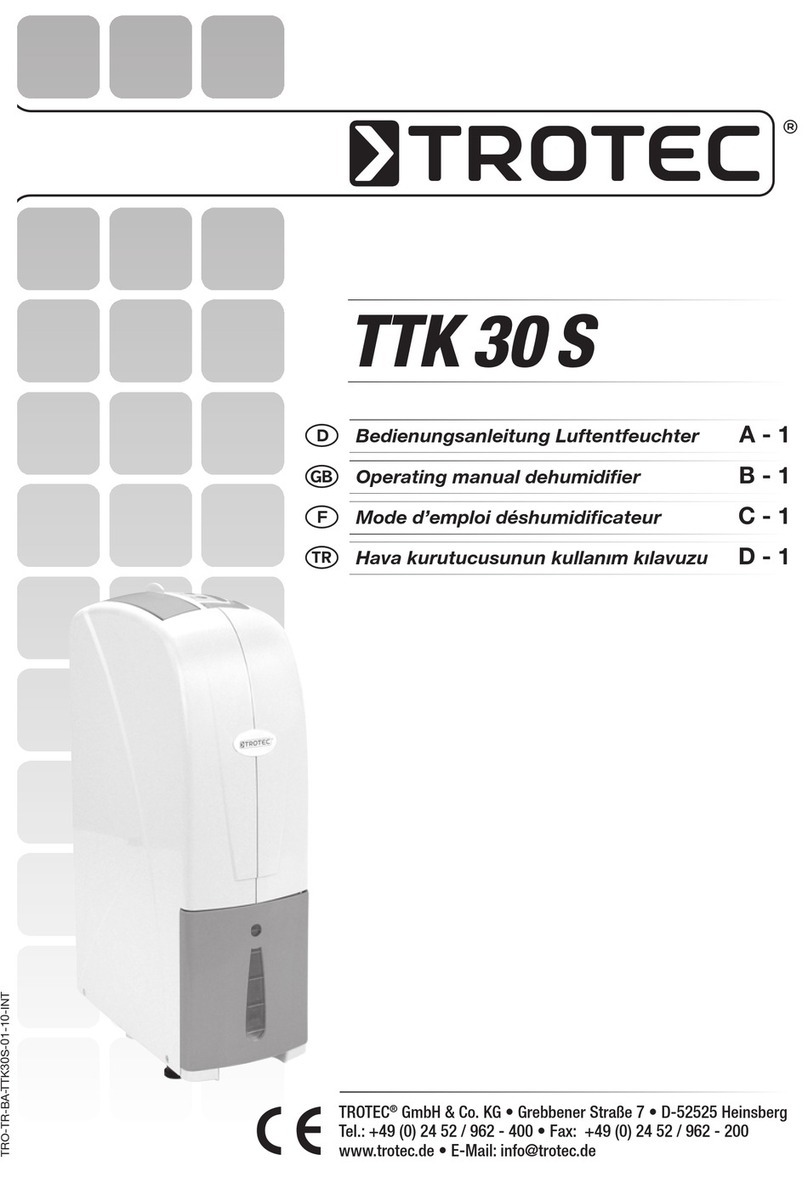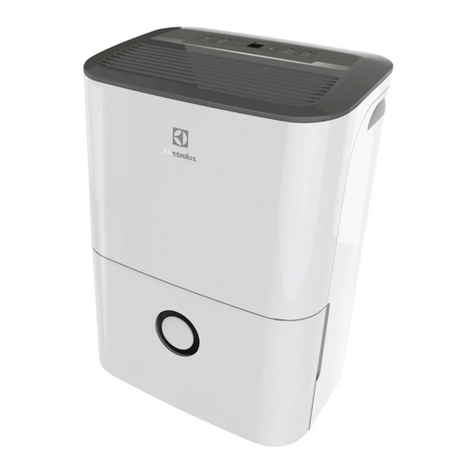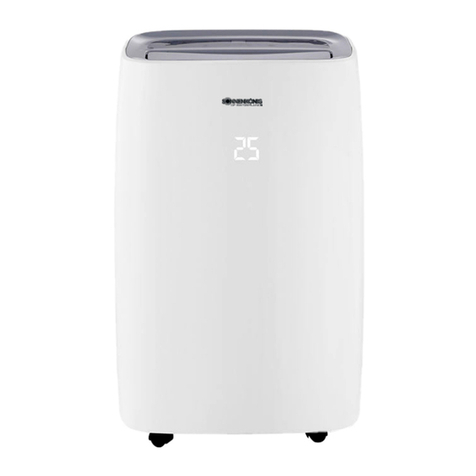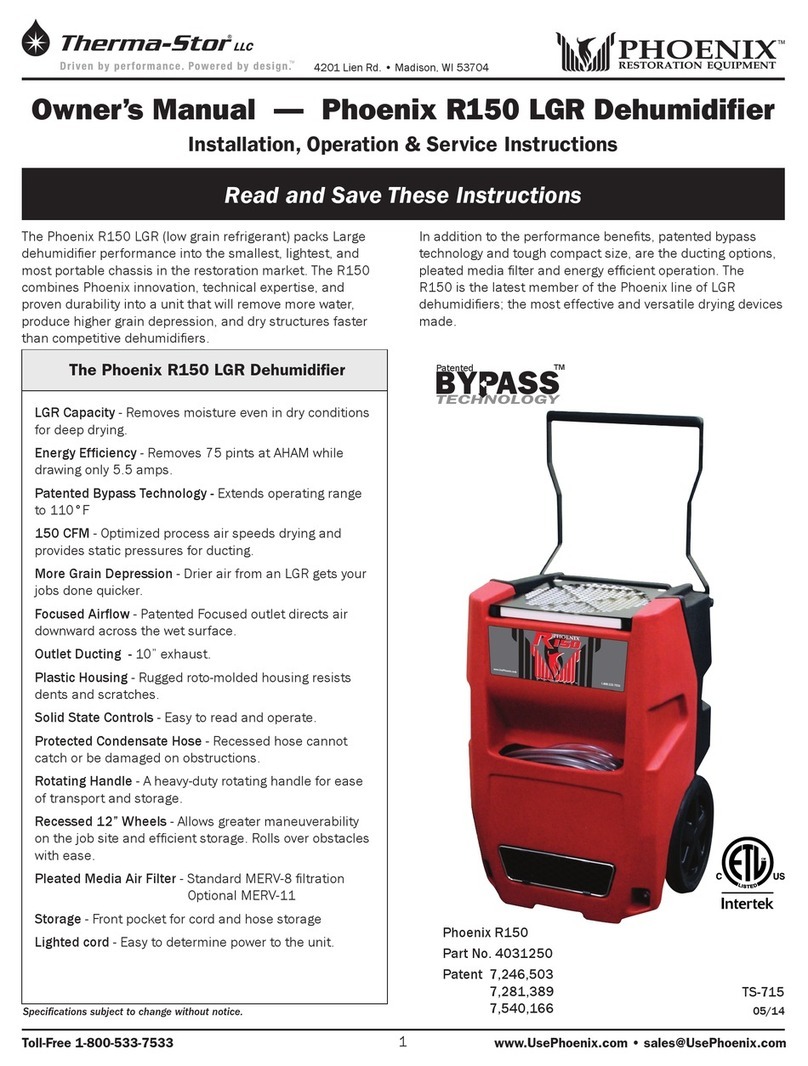Seresco NV Series User manual

SerescoDehumidifiers.com
OPERATIONS AND MAINTENANCE MANUAL
DEHUMIDIFIERS
NV SERIES

Table of Content
General Information....................................................................................................................... 2
Operating Safety (Warnings, Cautions, and Notes)...................................................................................2
Reference and Additional Information......................................................................................................3
Basic Information.......................................................................................................................................4
Dehumidifier External Systems Connection ..............................................................................................6
Layout and Components ................................................................................................................ 8
Dehumidifier Main Components ...............................................................................................................8
Control System.........................................................................................................................................10
Sequence of Operation ................................................................................................................ 11
Ventilation. ..............................................................................................................................................11
Purge (Additional Exhaust) Option. .........................................................................................................11
Heat Recovery Option..............................................................................................................................12
Air Conditioning and Dehumidification ...................................................................................................12
Space Heating ..........................................................................................................................................13
Space Cooling...........................................................................................................................................13
Interface and Communication ..................................................................................................... 14
Touch Display Operator Panel .................................................................................................................14
Remote Communication..........................................................................................................................16
Basic Maintenance ....................................................................................................................... 17
Maintenance and Safety..........................................................................................................................17
Maintenance Key Points..........................................................................................................................17
Specific Components Maintenance.........................................................................................................18
Pools –Equipment Warranty....................................................................................................... 20

Seresco NV Series OMM 2September 2020
General Information
This manual provides basic information about the applicable Seresco dehumidifier and its operation.
Important information regarding installation, maintenance, and start up as well as additional and auxiliary systems
and devices (outdoor condenser, communication interfaces, etc.) is normally provided with the dehumidifier and
can also be obtained from the manufacturer (see Contact Us below).
Operating Safety (Warnings, Cautions, and Notes)
FOR YOUR SAFETY: READ BEFORE PERFORMING ANY OPERATIONS, MAINTENANCE OR SERVICE TASKS!
Only qualified technicians should install, operate, maintain or service mechanical equipment
including current dehumidification system.
Make sure to read this manual before performing any tasks to familiarize yourself with the
equipment as well as with any potential hazards. Always exercise caution!
Beware of electrical power and high electrical voltage!
•Follow proper safety procedures –lockout, tagout, and other respective procedures
•Failure to follow safety procedures can result in serious injury or death
Beware of moving parts and hot surfaces!
•Make sure to stop all moving parts (fans, blowers, etc.) before accessing the equipment’s
internal space
•Be aware of hot surfaces (space heating pipes, coils, heaters, etc.)
Beware of chemicals!
•Some dehumidifiers may contain liquids such as glycol mixtures
The following warnings, cautions, and notes appear throughout this manual and referenced documentation
whenever special care must be taken to avoid potential hazards that could result in equipment malfunction or
damage, personal injury, or death.
WARNING
Indicates a potentially hazardous
situation which could result in
serious injury or death if handled
improperly.
CAUTION
Indicates a potentially hazardous
situation which could result in
moderate injury or equipment
damage if handled improperly.
Note
Indicates a situation that could
result in equipment damage or
improper/ineffective operation if
handled improperly.

September 2020 3Seresco NV Series OMM
Reference and Additional Information
For safe, efficient and problem-free operation, it is critical to handle the dehumidifier (as well as related systems
and components) properly at each step - from receiving and storage to installation and start up. Relevant
information can be found in the respective documents (like Installation Manual) provided with the dehumidifier.
This manual and other related documents could be obtained from the manufacturer (see Contact Us below).
Contact Us
Seresco
1071 Ages Drive
Ottawa, ON K1G 6L3
Canada
SerescoDehumidifiers.com
1-833-DAS-POOL (327-7665)
Schedule / Modify a Start-up:
Startups@DehumidifiedAirServices.com
Inquire about Warranty:
Warranty@DehumidifiedAirServices.com
Order Parts:
Parts@DehumidifiedAirServices.com
All Other Product Support:
Support@DehumidifiedAirServices.com
Start-up Requests: Start-ups@dehumidifiedairservices.com
Miscellaneous Inquiries: Support@dehumidifiedairservices.com
Parts Requests: Parts@dehumidifiedairservices.com
Warranty: Warranty@dehumidifiedairservices.com
Attention: Installation and Service Contractors
WARNING! Any work (installation, start up, service, maintenance, repair, etc.) on any mechanical
equipment must be performed in accordance with respective manufacturer’s recommendations as well as
submittal documentation, local Codes and Regulations, and appropriate field practices. Failure to do so could
result in personal injury, equipment damage or malfunction, and will void equipment warranty. Only qualified
and properly trained individuals should perform tasks on this equipment.
Attention: Maintenance Team
CAUTION. To ensure equipment longevity and proper and efficient operation, the dehumidifier and its
auxiliary systems and devices should be maintained properly and regularly. Failure to do so could negatively
affect premise comfort levels and people’s health. It could also lead to equipment damage, malfunction,
premature tear and ware and may void equipment warranty.

Seresco NV Series OMM 4September 2020
Basic Information
Dehumidifier View and Options
Seresco standard NV080 (BX cab) dehumidifier general views as well as some options are shown on Pic.C.1.
•Pic. C.1 shows only one example of dehumidifier arrangement –refer to submittal documentation for
specific details.
Pic. C.1

September 2020 5Seresco NV Series OMM
Dehumidifier Options
•Indoor or outdoor installation.
oPic. C.1. shows outdoor model, equipped with louvers (to protect air intake and discharge openings
from elements). Indoor model would have ducts connected to respective openings, no louvers would
be needed.
•Cabinets capable of delivering supply and outside nominal airflows* as follows:
oNV-080, BX Cab, 8,000 CFM
oNV-200, AA Cab, 20,000 CFM
oNV-320, CC Cab, 32,000 CFM
oNV-600, DD Cab, 64,000 CFM
* At 1” ESP. Airflow capability varies depending on external static pressure.
•Airflow/ductwork connection options * - as shown on Pic. C.1 and described below (some option locations
availability depends on the dehumidifier installation –indoor or outdoor):
oReturn Air (RA) ductwork connection - top, bottom, end, sides.
oSupply Air (SA) ductwork connection –top, bottom, sides.
oMin Outdoor Air (OA) ductwork connection/termination –top, sides.
oMin Exhaust Fan (EF) and Purge Fan (PF) ductwork connections/terminations –end, sides.
oPurge Outdoor Air (POA) ductwork connection/termination - top, sides.
•Optional Space Heating - hot water coil, electric or gas heater **.
•Optional Space Cooling –chilled water coil
•Optional Heat Recovery (HR) circuit.
* All available options (ductwork connections, aux options etc.) are shown. Refer to the submittal and other
relevant documentation for your dehumidifier’s options.
** For specific details on space heating (hot water, gas, electric) option, refer to the submittal and other
documentation:
•Gas-fired duct heater can be installed internally (fitted inside the dehumidifier at the factory) or provided for field
installation (to be fitted in the supply air ductwork).
•Electric heater or hot water coil, depending on capacity, model, size, etc., can be installed externally (mounted on the
top of SA opening or fitted in the supply air ductwork) or internally. Refer to your dehumidifier’s submittal
documentation.
Attention! Equipment Clearances and Dimensions!
CAUTION! For equipment proper operation, maintenance and service, respective clearances should be
maintained. Generally, 30” clearances to the equipment must be kept for the maintenance and service purposes.
For the specific required clearances information, as well as dehumidifier overall dimensions, distances to pipe
connections, duct connections etc., refer to the submittal documentation.

Seresco NV Series OMM 6September 2020
Dehumidifier External Systems Connection
Pic. C.1 shows provisions for external systems connections, including ductwork, electric power and control wires
and various piping connections.
All of the below piping systems are optional and may not be present in each dehumidifier.
•Condensate Drain Line (heat recovery) –bottom, side (through the dehumidifier base).
•Space Cooling connection –bottom, side.
•Space Heating (Hot Water connection) –bottom, side.
oSome connection location options, for heating pipe lines, are limited to indoor installation only –
refer to submittal documentation
•Space Heating (Gas Heater connection, gas line). If the dehumidifier is equipped with a gas heater (e.g. gas
furnace) for space heating purposes, the gas line connection is to be brought to the gas heater directly.
•Electric Power and Control Connection. Electric power is normally brought to the dehumidifier disconnect
(see Pic. C.1). If dehumidifier is not equipped with it, power lines to be brought directly to the main electric
panel. Also, provisions are made to bring control and communication connections through the dehumidifier
roof at the service vestibule.
CAUTION! This manual shows general/default connections’ location. For details regarding specific
dehumidifier’s connections (actual location, piping sizes and position dimensions, circuit type and flow direction
etc.), refer to the dehumidifier’s submittal documentation as well as dehumidifier’s labels and stickers.
NOTE. Dehumidifier MUST be equipped with a P-trap at the condensate connection for proper operation! If
dehumidifier is requested from the factory without P-trap, one MUST be installed on site prior to dehumidifier
being commissioned. Refer to the Installation Manual for details.
WARNING! Gas Line. The gas line must be installed in accordance with respective device documentation
and local codes and regulations.

September 2020 7Seresco NV Series OMM
Equipment Specific Data
Specific information for individual dehumidifiers is
provided in the following methods:
Main Label (Pic. C.5):the manufacturer tag attached
to the front of the dehumidifier includes the
dehumidifier’s most critical data:
General data including:
oSerial number
oDehumidifier model (nomenclature)
oDesign room conditions (air temperature
and humidity)
oHeat recovery glycol type & charge
Operational data, including:
oElectrical & airflow data (dehumidifier
voltage, CFM, etc.)
oAuxilliary system data (e.g. auxiliary
heating)
Labels and Stickers: attached when applicable to the
exterior and interior of the dehumidifier to show:
External systems connections location/direction
(space heating, space cooling, condensate)
Air filter locations, quantity, and size.
Additional Info (warning, caution stickers, etc.)
Wiring Diagrams: attached to the interior side of the
dehumidifier, depict dehumidifier control and power
wiring.
Attention! Glycol Circuits.
Unless otherwise indicated, equipment that is equipped with heat recovery option contains a heat recovery
circuit that is factory-charge with a water/glycol mixture; normally, rust inhibitor-infused food-grade propylene
glycol is used.
Glycol mixture concentration is normally shown on Main Label –refer as needed.
Note: The main label shown above is just an example.
Pic. C.5

Seresco NV Series OMM 8September 2020
Layout and Components
The general layout and components location is the same for all dehumidifiers of current type, however some may
vary, based on the dehumidifier’s specific options –refer to submittal documentation. Pic. D.1 below shows
all/most available options for the NV-080 (BX cab), some of which may not be present on your dehumidifier.
Dehumidifier Main Components
•Main Blower (1) is in the main blower compartment downstream of the min outdoor air opening.
•Main Electric Panel (2) is typically on the supply end. Some models are equipped with multiple main blowers.
•Min Outdoor Air (OA) Opening (4) is optionally equipped with a motorized damper and filter(s). The Manual
OA Damper (5) is usually used to set proper amount of outdoor air intake; in some cases, it could be equipped
with modulating actuator for automatic adjustment of outdoor air intake.
oOutdoor-installed dehumidifier would have louver(s) (76) installed at the OA opening.
•Optional Min Exhaust Fan (EF) Assembly (6) (fan and motorized damper) is located on the dehumidifier’s
return air side; Exhaust Air opening in outdoor-installed dehumidifier is equipped with louver(s) (76) also.
oMin Exhaust Fan Assembly is hinged and could be opened for better access to the fan electric box.
•Dehumidifier, equipped with Heat Recovery (HR) option, would have HR glycol coils (71), installed at the Min
Exhaust (EF) and Min Outdoor Air (OA) openings, and HR pump (72), installed in return air compartment.
oIf HR option is present, Min Exhaust Fan Assembly would normally be equipped with a filter rack.
•If dehumidifier is equipped with Purge option, additional Purge-exhaust fan (PF) (73) with motorized damper
would be installed on dehumidifier’s return air side, as well as additional (“Purge”) Outdoor Air (POA) (74)
opening(s), equipped with motorized dampers, would be located directly upstream of Main Filter Rack (9).
Motorized Return Air (RA) damper (75) would be located between return air side and POA opening(s).
oOutdoor- installed dehumidifier would have louvers (76) installed at the Purge-exhaust fan and Purge
Outdoor Air openings.
•Main Filter Rack (9) is downstream of POA openings to protect downstream hot water or chilled water coils.
•Space Cooling (10b), option that may be present in some models as a chilled water coil, typically located
downstream of the main filter rack.
•Space heater (11a and 11b) location, if the dehumidifier is equipped with one, may vary:
oHot water coil or Electric heater (11a) is usually located downstream of the main filter rack;
oGas heater (11b) is usually located immediately after the main blower(s), however, in some cases it
could be installed externally.
•Main Electric Panel contains Main Control Board (17), Operator Panel (18) and other electrical components.
Disconnect (77), if one is installed, is usually located on the outer wall, opposite to Main Electric Panel.

September 2020 9Seresco NV Series OMM
11b
2
1
5
4
9
11a
18
17
Pic. D.1
74
72
75
71
73
6
71
76
76
76
76
77
21
22
10b
29
24

Seresco NV Series OMM 10 September 2020
Control System
The dehumidifier control system is composed of sensors, spread throughout the dehumidifier, Main Control
Board, Operator Panel and other electric components, located in the Main Electric Panel.
Temperature Sensors (Pic. D.2):
a) Temperature sensors (thermistors) are used to monitor air
and water temperature;
b) Combo sensor is used to monitor air temperature and
humidity.
Sensors and safeties approximate location is shown on Pic. D.1 in red.
•RA Combo Sensor (21) measures temperature and humidity of the pool room air (Return Air) entering the
dehumidifier. It is located at the return air ductwork connection to thedehumidifier.
•OA Temperature Sensor (22) measures outdoor air temperature; it’s located at the OA filter rack.
•As an option, the combo sensor (instead of regular thermistor) can be installed at the OA intake to measure
both the temperature and humidity of the outdoor air.
•SA temperature sensor (24) measures the temperature of the air leaving the dehumidifier (supplied to the
premise). It must be located downstream of the space heater:
oIn some cases, where the space heater is external to dehumidifier, the sensor will be provided with
the dehumidifier to be field-mounted into the supply air ductwork downstream of the space heater.
•If dehumidifier is equipped with Heat Recovery option, it could also have Exhaust Air (EA) Temperature
Sensor (29), installed downstream of exhaust-side located heat recovery glycol coil.
•Main Electric Panel, apart from devices listed above (control board, OP, etc.) also contains Voltage Monitor;
some optional control sensors and devices such as an air pressure differential sensor, current sensor(s). It may
also be located in main electrical panel or in the dehumidifier in general.
b
a
Pic. D.2

September 2020 11 Seresco NV Series OMM
Sequence of Operation
The dehumidifier’s ventilation system establishes the required airflow through the dehumidifier. The control
system compares air temperature and humidity to their desired values (set points) and proceeds to dehumidify,
cool or heat the recirculating air.
Set Points
The control system is constantly adjusting unit operation to achieve and maintain said parameters within couple
degrees/percent of the set point.
Refer to the dehumidifier’s main label for the design value of control parameters, as well as the following note.
Ventilation.
The main blower runs continuously, establishing required. The main blower speed is pre-set via adjustable variable
signal.
Minimum Exhaust Fan (EF), if dehumidifier is equipped with such option, directs portion of return air outdoors.
Like main blower, exhaust fan(s) speed is also controlled via adjustable (pre-set) variable signal, that varies based
on scheduled ventilation mode (Occupied, Non-Occupied and Spectator) or call for Economiser Mode (as part of
Air Conditioning and/or Dehumidification operation).
Minimum Outdoor Air (OA) damper, if dehumidifier is equipped with such option, opens to introduce fresh
outdoor air into the premise. OA damper could be equipped with ON/OFF (simple fully open –fully closed) or
modulating-controlled actuator; latter one would be controlled same way as minimum exhaust fan.
Purge (Additional Exhaust) Option.
Along with Min Exhaust Fan and Min Outdoor Air damper, dehumidifier could have additional set of exhaust
(purge) fan(s) (PF) and purge outdoor air damper (POA), commonly referred as Purge. Purge fan(s) and OA
damper(s) function is to allow for higher exhaust and fresh air amount, up to complete (100%) air changeover
(when all exhaust fans and OA dampers are at their max capacities).
Purge Fan(s) and Purge Outdoor Air damper(s) are controlled in the same fashion as min exhaust fans and min
outdoor air. Some dehumidifiers may be equipped with additional Return Air damper: it closes in event of
complete air changeover, separating return air side of dehumidifier from supply side (refer to Layout and
Components chapter, as needed, for respective devices’ location).
Complete air changeover, triggered manually, is known as Purge Mode.
•Note. Externally installed Exhaust Fan(s) and Outdoor Air damper(s) could be also controlled by the
dehumidifier control system. This applies to both, Minimum and Purge/Additional, fans and dampers.
Note: To ensure the dehumidifier’s most economical operation, we recommend maintaining the following
relationship between pool water and room air temperatures:
Room Air T = Pool Water T + 2˚F

Seresco NV Series OMM 12 September 2020
Heat Recovery Option.
Dehumidifiers, packaged with Minimum Exhaust Fan and Minimum Outdoor Air damper, could also have
additional Heat Recovery (HR) closed-loop glycol system.
Heat Recovery loop (see Pic. E.1 below) consists of two coils (air-to-glycol heat exchangers) and a pump,
establishing glycol circulation between them. One coil, installed at exhaust air opening, recovers portion of
exhausted air energy, another coil, installed at outdoor air intake, transfers this captured energy to entering
outdoor air.
Air Conditioning and Dehumidification
When premise air temperature goes over (exceeds) its set point, the dehumidifier control system issues a call for
Air Conditioning Mode. Respectively, when premise air humidity goes over (exceeds) its set point, the dehumidifier
control system issues a call for Dehumidification Mode. In some instances, these calls may co-exist.
To execute Dehumidification or Air Conditioning (Cooling) mode, control system, depending on current conditions,
would resort to available means of cooling or dehumidification.
Economiser Mode Option.
Note: Economiser Mode requires dehumidifier to be equipped with full (min and additional) exhaust and outdoor
air options!
If outdoor air is dry and/or cool, it could be used to dehumidify and/or cool the premise. In this case, on call for
Dehumidification or Air Conditioning mode(s), control system would simply increase exhaust fan(s) speed signal to
direct more stale return air outside and bring in more outdoor (dry/cool) air in, thus reducing supply air humidity
and/or temperature (as needed).
Pic. E.1

September 2020 13 Seresco NV Series OMM
Space Heating
When premise air temperature drops below the set point, the dehumidifier control system issues a call for Space
Heating Mode and engages space heater (electric heater, hot water coil with valve, gas boiler etc.) by sending space
heating signal, respective to space heater control type - on/off, variable (0-10VDC), etc.
Space Cooling
When premise air temperature rises above the set point, the dehumidifier control system issues a call for Space
Cooling Mode and engages space cooler (Chilled water coil with valve) by sending space cooling signal, respective to
space cooler control type - on/off or staged (multiple on/off valves).

Seresco NV Series OMM 14 September 2020
Interface and Communication
Touch Display Operator Panel
The Touch Display Operator Panel (OP), shown on Pic. F.1, is used as a main interface between the dehumidifier
and operator. The same OP can be located in the dehumidifier main electric panel (default; used as a local OP) or
installed remotely from the dehumidifier
•NOTE: length of CAT5 or CAT6 cable, between remote OP and the dehumidifier MUST NOT exceed 1000’!
Touch Display OP allows to:
Access Touch Display Menus
View dehumidifier current operational
statuses (Touch Display Communication,
Alarms, dehumidifier operational calls, etc.)
View controlled parameters’ values (premise
air temperature, humidity and, if applicable,
pool water temperature) and current date
and time.
Touch Display Menus:
Home
Opens/returns to the home page
Logs
Access to dehumidifier logs and log-related features (Alarms, etc.)
User
Access to user settings (Setpoints) and commands (Stop/Restart Dehumidifier, etc.)
Advanced
Access to advanced settings and features
Help
Context sensitive help presenting information related to the viewed page
Most common/basic maintenance tasks performed using Touch Display OP
Adjust Setpoint –in User menu: press the User button, then press the Setpoints button; select desired
parameter (room air temperature etc.) and enter the desired value. Press the Enter button to confirm the
entered value.
Stop/Restart Dehumidifier –– in User menu: press the User button, then press the System Restart button;
oTo stop and restart dehumidifier, press the System Restart button
oTo reboot Touch Display OP, press the Restart Display button
Review Alarm records –– done via the Logs menu: press the Logs button, then press the Alarm Log button.
Unlock device/dehumidifier, stopped and currently locked out on the alarm –– done via Logs menu: press
the Logs button, then press the Current Alarms button; press the Clear button next to the respective alarm
(the alarm that’s locked out the device or entire dehumidifier).
For detailed information on TouchDisplay OP refer to DASV Touch Display Manual, provided with the dehumidifier
(or contact factory to obtain a copy).
Pic. F.1

September 2020 15 Seresco NV Series OMM
Alarms
If the dehumidifier control system detects abnormal or unsafe for further operation situation, it issues Alarm
(notification of such situation accompanied by respective component or entire dehumidifier stoppage and/or
lockout) or Alert (notification of minor abnormal situation without any devices’ stoppage or lockout).
All alarms and alerts are recorded and can be viewed/cleared via the Touch Display OP:
Viewed: to facilitate troubleshooting and addressing abnormal situation
Cleared: to unlock stopped device or entire dehumidifier and allow for further operation
The table F.1 below lists the basic alarms with their descriptions and recommended initial troubleshooting.
Table F.1. Most Common Alarms/Alerts
Alarm
Alarm Description
Check
No Air
No air flow (air flow switch fault –if air flow
switch is installed)
Check main blower operation and air flow
switch
Blower OL
Main Blower overload/safety fault
Check main blower operation and its LED
light blinking pattern.
Fire
Fire/smoke detector fault –if detector is installed
externally and connected to control board
Check external fire/smoke
detector/system
Freeze
Supply Air temperature is lower than Freezestat
Setting (default: 45 F)
Check SA temperature readout, space
heating system operation
Filter
Alert, indicating that filter change timer has
lapsed –if timer is activated
Clear the Filter alarm and cancel filter
scheduler if not in use.
VM
Voltage Monitor fault –power supply (phasing,
voltage etc.) is outside of pre-set limits
Check Voltage Monitor info/status,
incoming power (voltage)
Heat
Recovery OL
Active when there is a heat recovery pump
overload alarm
Check heat recovery pump operation
Note that proper and regular maintenance (example: keeping air filters and air-side coils clean) should
reduce the chances of abnormal operations, dehumidifier alarm-related stoppages and downtime.
For more details regarding alarms and alerts, refer to the Alarms Description information (available via Help
feature in Touch Display OP); contact factory if needed.
CAUTION! We recommend you have a qualified professional investigate and remedy all reoccurring
alarm-related stoppages and lock-outs. Continuous dehumidifier restarting (clearing alarms) without addressing
actual issues may result in equipment malfunction, premature wear, and failure.

Seresco NV Series OMM 16 September 2020
Remote Communication
Although dehumidifier is designed to operate as a self-controlled device (not requiring any external control),
communication between the dehumidifier and external control and monitoring systems is possible.
WebSentry
WebSentry is an online tool (also referred to as Web Monitor), that allows for remote communication to the
dehumidifier for various purposes such as monitoring, data collection, parameters adjustment, and notifications.
This feature is included with all dehumidifiers and is useful for maintenance teams and service providers (HVACR
technicians).
To establish Web Monitor communication, the dehumidifier must communicate with the factory server via the
Internet:
-Connect the dehumidifier to a local network switch, router or wireless AP device (providing connection to a
local network):
oPlug an Ethernet cable into the sub-board Ethernet RJ-45 jack (sub-board, called Core Module, is
located on the main control board in the main electric panel) –see Pic. F.2.
Note: separate RJ-45 jack (plastic, black) is mounted on the control board directly, for
TouchDisplay connection. Make sure to use the proper jack (metal-surface one, located on
the sub-board) for Web Monitor connection.
-Configure, as needed, local server and dehumidifier network settings.
BMS (Building Management System)
Communication to BMS can also be supported, depending on the
type of communication protocol said BMS utilizes.
The equipment control software supports most common of them
-different control software variation might be required to
support different BMS communication protocols. Contact
factory if necessary.
BACnet (Internet, IP). Communication is established via the
Ethernet cable (same method as Web Monitor).
BACnet and Web Monitor communication can be used
simultaneously.
LON or Modbus. Communication requires external wiring
between dehumidifier main control board and BMS terminal.
Wiring schematic is normally indicated on wiring diagram
(provided with dehumidifier).
If dehumidifier is equipped with LON communication option,
it’s normally provided with pre-wired LonWorks Gateway for
communication purposes.
For more information about Web Monitor or BMS communication
set up (connection, configuration, access, point cutsheets, etc.) –
contact factory.
Pic. F.2

September 2020 17 Seresco NV Series OMM
Basic Maintenance
Although Seresco equipment is built for minimal service downtime, periodic preventative maintenance is required
to ensure maximum reliability, safety, and operating efficiency.
Maintenance and Safety
Only qualified/properly trained personnel should attempt to perform respective maintenance tasks.
•When it is necessary to work with live electrical components, have a licensed electrician or other qualified
professional perform the required task.
•Be properly trained and equipped. Some maintenance tasks may involve usage of power tools, chemicals, etc.
Refer to such tools and materials data (manuals, MSDS, etc.). Responsible maintenance personnel should be:
oProperly trained to handle such tools and materials safely
oEquipped with proper personal protective equipment
•Turn the power off. Before performing any maintenance, disconnect all electrical power, including remote
disconnect, and discharge all energy storing devices (VFDs, etc.) before servicing. Follow proper lockout
procedures to ensure that power cannot be accidentally restored. Failure to follow provided safety warnings
and labels could result in serious injury or death.
•Be aware of potential hazards. The equipment contains moving mechanical parts and surfaces with high
temperatures. Before entering the dehumidifier and/or performing any equipment maintenance work, make
sure that all moving parts are stopped, and it is safe to perform required task.
Maintenance Key Points
Here are some basic/key maintenance considerations, pertinent to all dehumidifiers and their auxiliary systems:
•Dehumidifier in mechanical room. No chemicals should be stored in the same mechanical room where the
dehumidifier is installed. Chemical fumes/off-gas can cause premature deterioration of the equipment.
oStore chemicals in a separate, well-ventilated room.
•Access to the Equipment. Ensure that the equipment is accessible (minimum clearances are maintained):
approaches to the dehumidifier are not restricted/limited with materials in mechanical room (indoor installed)
or with snow (outdoor installed dehumidifiers, OACC and OAFC).
•“MUST DO” maintenance task. Although all other maintenance tasks are as important, these two maintenance
tasks are the most common and most helpful:
oMaintain clean air filters (return, outdoor air filters, etc.). Make sure to replace dirty filters regularly.
oMaintain clean air-side coils. Make sure to clean coils regularly.
•Pool Water Chemistry. Incorrect pool water chemistry (improper pH level or high concentration of chlorine,
sea salt or other corrosive additives etc.) can result in equipment premature wear or malfunction (let alone
poor air quality in the pool and potential health issues) and will void the equipment warranty. Refer to pool
water quality standards; contact factory as needed.
WARNING! To ensure equipment longevity and proper and efficient operation, the dehumidifier and its
auxiliary systems and devices must be maintained properly and regularly. It is recommended to create a facility-
specific Routine Maintenance Program.
Failure to maintain the equipment properly and regularly could result in personal injury, equipment damage or
malfunction and will void the equipment warranty.

Seresco NV Series OMM 18 September 2020
Routine Maintenance Program
Creating facility-specific routine maintenance program and following it is vital to equipment longevity and efficient
operation.
The suggested general maintenance operations and their frequency/intervals, listed in the table M-1 below, can be
used to create such a program. For more detailed maintenance recommendations related to specific components,
refer to the respective component manufacturer’s manual.
Specific Components Maintenance
Actual maintenance plan may vary from installation to installation, yet there are several key components from
maintenance prospective.
If needed, contact respective component manufacturer for additional maintenance information.
Filters
•Ensure air filters are clean. Dirty air filters will negatively affect dehumidifier performance and lifetime
Table M.1. Recommended Maintenance Tasks and Intervals
Interval
Maintenance Task
Weekly
Observe the equipment for any changes in running conditions and unusual noise
Quarterly
Clean or replace air filters if clogged or dirty
Verify that all set-points are correctly programmed as specified by the facility operator
Semi-
Annually
Inspect and clean the drain pan(s)
Tighten electrical connections, if required
Inspect all airside coils for dirt, cobweb build-up, etc.; clean as needed
Check that the P-trap is primed (filled with water). It is good practice to pour some water into the
drain pan to ensure that the P-trap is primed and operational
Check the outdoor air louvres and dampers for accumulation of dust and clean as required
Inspect the equipment’s cabinet for corrosion. If any damage is found, clean and repaint the
affected surface with a rust-resistant primer
Annually
Clean the fan wheel(s)
Check dampers operation (linkage/actuator is not loose, damper opens/closes properly etc.)
Inspect electrical components, wiring and insulation
Rotate the fan wheel(s) and check for obstructions and rubbing
Check gasket condition on all doors to ensure an airtight seal
Check bolts on motor mounts, dehumidifier bases and coils and tighten if required

September 2020 19 Seresco NV Series OMM
•Frequency of filters replacement will vary based on air quality, dehumidifier usage, facility type, etc. Make
sure to replace filters regularly
•Replace with filters of equivalent size and rating –refer to dehumidifier details (compartment stickers, etc.)
Insulation
Inspect dehumidifier insulation, exposed to airstream for microbial growth (i.e., mold). If there is evidence of
microbial growth on the interior insulation, the insulation should be removed and replaced prior to operating the
dehumidifier.
Air-Side Coils
•Warning: Hazardous chemicals! Cleaning agents can be highly acidic or alkaline. Handle all chemicals carefully
and use appropriate personal protective equipment (PPE). Refer to the cleaning agent manufacturer's Materials
Safety Data Sheet (MSDS) for safety and handling information. Failure to follow all safety instructions could
result in serious injury or death.
•Warning: Hazardous pressures! Coils must not be cleaned using a solution over 150 ºF. Failure to follow these
safety precautions could result in coil bursting, which could result in serious injury or death.
To clean the coil
•Disconnect all electrical power to the equipment
•Use a soft brush to remove loose debris from the coil
•Mix a high-quality coil cleaning detergent with water according to the manufacturer's instructions
•Clean coil according to suggested instructions
•Thoroughly rinse both sides of the coil and the drain pan with, clean water
•Straighten any coil fins that have been bent during the cleaning process
•Confirm the drain line is clear
•Replace all panels and parts and restore electrical power to the equipment
This manual suits for next models
4
Table of contents
Other Seresco Dehumidifier manuals

